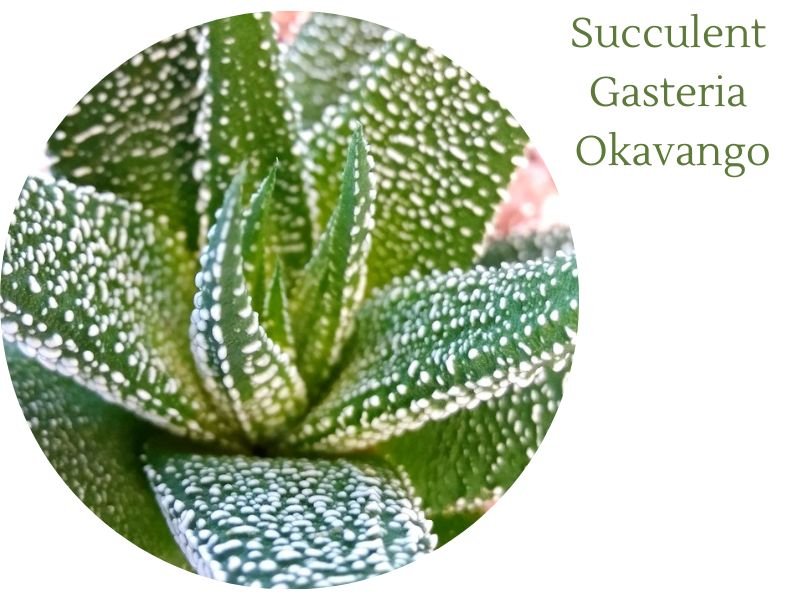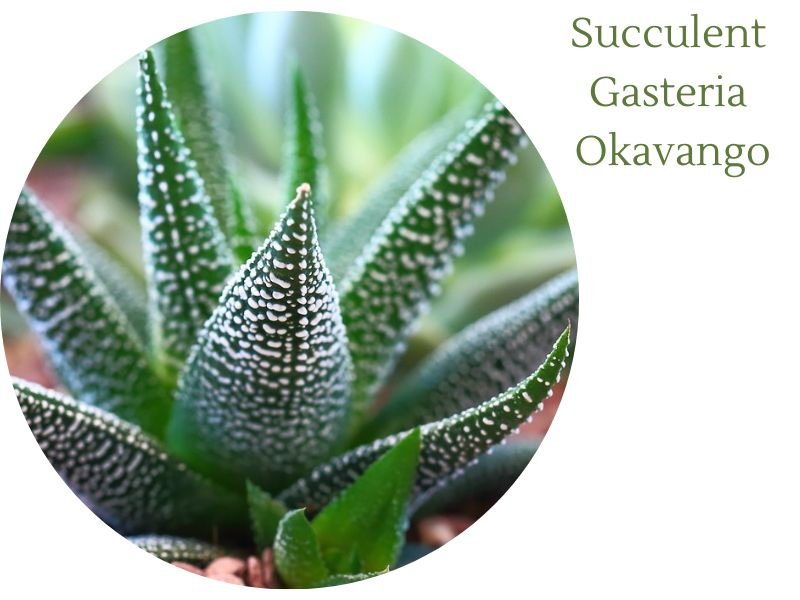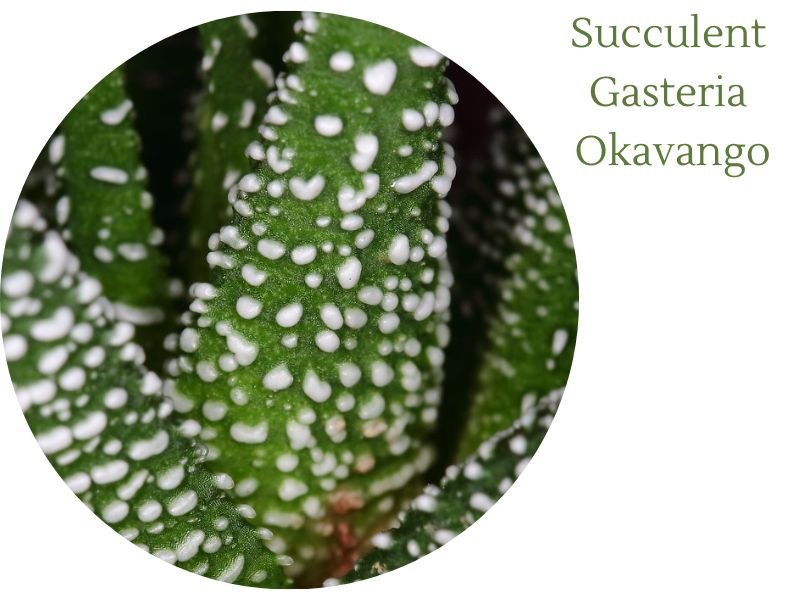Table of Contents
The Little Succulent With a Big Personality
Succulent Gasteria Okavango is a charismatic little plant that has taken the houseplant world by storm. Its quirky and interesting appearance, combined with its low-maintenance nature, has made it a popular addition to many homes.
This species of Gasteria do not scientifically record or classify yet, with no real research data or factual study on this genus. It doesn’t classify in any subspecies of the Gesteria or Asphodelaceae family plant just yet. Some claim that this Gasteria is originally from Botswana, specifically the Okavango delta river but the vegetation on this delta is not ideal for a deserted plant like Gesteria, and once again no record of this plant being found in this region. the claim is purely from the similarity in naming.

This unique succulent is native to South Africa and is part of the Aloe family. It has thick, fleshy leaves that are often marked with intricate patterns or stripes.
Why Gasteria Okavango is So Popular
The popularity of Gasteria Okavango can be attributed to several factors.
- Firstly, it’s an incredibly resilient plant that thrives in a range of conditions. Whether you’re new to gardening or have years of experience, this succulent will not disappoint.
- Additionally, it’s a versatile plant that can be used in many different ways – from adding character to your work desk to sprucing up your living room shelf. But perhaps the most appealing aspect of Gasteria Okavango is its striking appearance. Each leaf has its own unique design, ranging from intricate spots and dots to bold stripes and lines. This variety makes it a visually interesting plant that draws attention wherever it’s placed.
- Plus, because it’s small in size and easy to care, it’s perfect for anyone who wants some greenery at home but doesn’t want something too complicated or difficult to look after.
Overall, there are many reasons why Succulent Gasteria Okavango has become one of the most beloved houseplants on the market today – from its striking appearance to its low-maintenance nature – making it an ideal choice for any indoor gardener looking for something special!
Appearance and Characteristics

When it comes to the succulent family, gasteria okavango is easily one of the most visually stunning plants you can find. This particular plant’s physical features are truly unique and eye-catching. It boasts thick, fleshy leaves that are green in color with white spots, almost resembling a leopard’s fur coat.
The leaves are arranged in a rosette pattern, each measuring around 3-4 inches long. The plant’s stem is short and sturdy which makes it perfect for small pots or to be grown in clusters.
The gasteria okavango also has an interesting growth pattern that allows the plant to adapt to its environment over time. This means that if you place your gasteria okavango in different lighting or temperature conditions, its leaves will start growing in different shapes and sizes accordingly.
Discussion on Unique Characteristics
Besides its obvious aesthetics, the succulent gasteria okavango also has some unique characteristics that really make it stand out from other houseplants.
For starters, this plant is extremely low maintenance and can thrive even with minimal attention. It requires very little water – only about once every 2-3 weeks – making it perfect for those who tend to forget their plants’ watering schedules.
Another unique feature of this plant is its ability to purify the air around it by removing toxins such as benzene and formaldehyde from the atmosphere.
So not only does this plant look great on your desk or windowsill, but it’s also working hard behind the scenes to keep you healthy!
Habitat and Growing Conditions

The Desert Dweller
The succulent gasteria okavango is a plant native to the deserts of South Africa. It’s no surprise that this plant has adapted to survive in harsh conditions with little water, as it belongs to the succulent family.
The gasteria okavango thrives in rocky, well-draining soil and can withstand prolonged periods of drought. However, too much water can quickly lead to root rot leaving your plant looking sad and droopy.
Recreating Ideal Growing Conditions
To successfully grow a gasteria okavango at home, you’ll need to recreate its ideal growing conditions as closely as possible. This means providing it with bright but indirect sunlight and a soil mix that drains well – think sandy soil with added perlite or pumice for extra drainage power. Watering should be done sparingly, allowing the soil to fully dry out between watering sessions.
Don’t Overcomplicate It
While there are certainly specific requirements for growing the gasteria okavango, this doesn’t mean that growing it has to be a complicated task. The key here is simple – don’t overthink it!
If you provide your plant with well-draining soil, adequate sunlight, and moderate watering sessions, you’ll have a happy and healthy gasteria okavango on your hands in no time.
Creating an environment similar to its natural habitat is crucial for the success of this desert-loving plant. Following these simple tips will enable you to enjoy an elegant greenery without much hassle or maintenance required from your end!
Watering and Feeding
To Water or Not to Water: That is the Question
Succulent gasteria okavango are known for their ability to store water in their leaves and stems, making them drought-tolerant. However, this does not mean that they should be left completely dry. In fact, overwatering is one of the most common mistakes people make when caring for these plants.
So, how often should you water your succulent gasteria okavango? The answer depends on a few factors such as the temperature of your home and the humidity level in your area.
As a general rule, water your plant only when the soil is completely dry to avoid root rot. In warmer months, this can be once every two weeks but during winter it can be once a month or even longer.
Soil Matters
The type of soil you use for your succulent gasteria okavango is also important in keeping it healthy. The ideal soil for these plants is well-draining with a pH between 6.0 and 7.5.
Avoid using regular potting soil as it retains too much moisture which can lead to root rot. Instead opt for a mix that includes sand, perlite, or pumice which helps ensure good drainage. You can make your own mix by blending cactus/succulent potting mix with an equal part of sand or perlite or you can purchase ready-made mixes from the garden store.
Fertilizing Your Plant
Feeding your plant regularly will help keep it healthy and vibrant-looking but overfeeding can harm its growth so moderation is key here. Use a balanced liquid fertilizer diluted according to package directions during the growing season (late winter-early fall).
Apply every four weeks while watering. Don’t fertilize during winter months when the plant is dormant.
Be careful not to let fertilizer sit on the leaves as this can cause damage. With the right watering, soil, and feeding schedule your succulent gasteria okavango will thrive and brighten up any space with its lovely foliage!
Propagation Techniques

The Beauty of Propagation
Propagating succulent gasteria okavango is a fun and rewarding experience, allowing you to create numerous plants from a single-parent plant. Propagation techniques for this species include leaf cuttings, offsets, and seeds. Each method has its own advantages and disadvantages, but all can result in healthy new plants with proper care.
Leaf Cuttings
Leaf cuttings are one of the most common methods of propagating succulents like gasteria okavango.
- To do this, simply remove a healthy leaf from the parent plant and let it dry out for a few days to prevent rotting.
- Once the leaf has formed calluses at the base, place it into well-draining soil and keep it slightly moist until roots have developed.
- After that, water sparingly as needed to prevent over-watering.
Offsets
Offsets are another common propagation method for gasteria okavango. These are small offshoots that grow from the base of the parent plant.
To propagate through offsets, simply remove them from the parent plant once they have matured and let them dry out for a few days before planting them in well-draining soil. Keep the soil slightly moist until new roots have developed.
Seeds
Propagation through seeds can be challenging but rewarding when done correctly. Collect seeds from your matured gasteria okavango plants after they flower and develop seedpods in the late summer or early fall season when seedpods begin opening up to reveal their black seeds inside of them. Propagating succulent gasteria okavango through methods such as leaf cuttings or offsets can be an enjoyable experience that allows you to create numerous healthy new plants with proper care.Plant enthusiasts should explore these methods and find which ones work best for them.
Pests and Diseases
The Dreaded Pests
Ugh, pests. They are the bane of every plant lover’s existence, and no matter how vigilant you are, they always seem to find a way to infiltrate your precious plants. The succulent gasteria okavango is no exception to this rule.
One of the most common pests that can affect this plant is mealybugs. These little critters look like tiny pieces of cotton and love to hide in the crevices of your plant’s leaves.
Another pesky pest that can infest this succulent is spider mites. These tiny arachnids suck the sap out of your plant’s leaves, causing them to yellow and wither away.
Recognizing Signs of Infestation
So how do you know if your succulent gasteria okavango is being attacked by these pests? Look for sticky residue on the leaves or small white bumps that move when touched – these are signs of mealybugs. If you notice tiny webs forming over the leaves or see small black dots (which are actually spider mites), it’s time to take action.
Prevention and Treatment Tips
Prevention is key when it comes to keeping pests at bay from your beloved plants. Always inspect new plants before bringing them home, isolate new additions for a couple of weeks after purchase in case they carry any unwanted guests, and keep humidity levels low as mealybugs love humid environments.
If an infestation does occur, there are several treatment options available such as using insecticidal soap or neem oil which can be sprayed directly onto the infected areas. Remember though that prevention is easier than treatment so try not to let any outside plants make contact with those inside if possible which will help control infestations right from the start!
Decorative Uses
Incorporating Gasteria Okavango into Your Home Decor
Gasteria Okavango is an incredibly versatile and aesthetically pleasing plant that can be used in a variety of ways to enhance your home decor. Its unique characteristics and fascinating appearance make it an eye-catching addition to any room in the house.
- One fun idea for incorporating this plant into your decor is to create a mini-succulent garden using a variety of different gasterias and other similar succulents. This can be done by planting several small plants into one large pot or even using individual pots for each plant.
- Another great way to utilize Gasteria Okavango is by placing it on shelves or tables as a decorative accent. The plant’s interesting shape and coloring make it stand out against other decorative items, making it perfect for adding some visual interest to any space.
It’s also important to keep in mind that this succulent thrives in bright, indirect light, so be sure to choose a spot where it will receive plenty of light throughout the day.
Insight into How Gasteria Okavango Can Be Used
Aside from being used as a decorative element, Gasteria Okavango has many practical uses as well. For example, its thick leaves hold water very well, making it an excellent choice for those who may not have the time or inclination to water their plants regularly. Additionally, its air-purifying qualities make it an ideal choice for improving indoor air quality.
One creative way that Gasteria Okavango can be utilized is by incorporating it into natural health remedies such as teas or tinctures. The gel-like substance inside the leaves has healing properties that can aid with digestion and alleviate minor skin irritations when applied topically.
Conclusion
Gasteria Okavango is a fascinating and unique succulent that is both aesthetically pleasing and practical. Its versatility makes it a great choice for those looking to incorporate plants into their home decor while also improving indoor air quality.
With the right care, this plant can thrive for many years, bringing beauty and life to any space it inhabits. So why not consider adding Gasteria Okavango to your plant collection today?

Gardening is my passion and growing plants indoors has always been a stress relief for me. Grow a banana tree in my apartment once (although failed to produce bananas).






